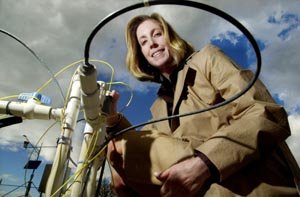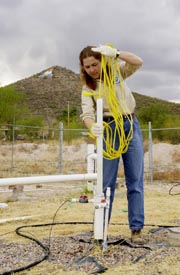Landfills can't wait

Photos by James S. Wood / Staff
Masbruch says the city intends to begin
another pilot project before the full stabilization project
is projected to begin in 2003.

Environmental scientist Molly Collins
bails water from a monitoring point near "A" Mountain.
Air, water speed decomposition greatly; Rio Nuevo likely
to benefit
By Eric Swedlund
ARIZONA DAILY STAR
Forcing air and water into the heart of three landfills
at the base of "A" Mountain will speed their decomposition
from about 150 years to three years, a city experiment indicates.
The technique will provide stable ground for projects at
the west end of the Rio Nuevo Downtown revitalization project,
said Karen Masbruch, the city's environmental management
director.
Natural decomposition isn't an option because it could
yield explosive levels of methane gas under new buildings.
Another alternative would be to dig up the landfills and
carry off the 1.7 million cubic yards of trash, but that
would cost more than $50 million.
Rio Nuevo plans set aside $2.3 million for the landfill
stabilization project.
The three landfills, Nearmont, Congress and "A" Mountain,
occupy 50 acres south of West Congress Street and west of
the Santa Cruz River. They are up to 40 feet deep and contain
garbage dating to the early 20th century.
Their area will become home to the San Agustín de
Tucson mission reconstruction, the Rancho Chuk Shon cultural
center and large areas of open space, said Rio Nuevo project
director John Jones.
The city pilot project pumped air and water into a 50-by-50-foot
parcel of the Nearmont landfill from July 24 to Dec. 20.
Under normal conditions, a landfill will settle about 1
inch per year. With this technique, city officials recorded
an average settlement of 10 inches in just 82 days.
Naturally occurring microbes degrade garbage and reduce
methane, and the project simply sped up the process, said
Gary Walter, president of Hydro Geo Chem Inc., a local environmental
consulting firm that performed the study.
The rate of degradation reported by the city, about 100
times as fast as natural decomposition, would stabilize
99 percent of the garbage at Nearmont in just over two years.
The city also monitored soil and ground-water samples
and reported "no cause for environmental concern."
Methane levels decreased significantly during the study,
while oxygen and carbon dioxide increased.
Walter said samples from around the landfill indicate few
or no hazardous chemicals are buried there.
Even though water is being used in the landfill, the technique
has sufficient controls to protect the aquifer from trickle-down
pollution, said Arizona Department of Environmental Quality
spokesman Patrick Gibbons.
Masbruch said the city intends to begin another pilot project,
covering three acres, before the full stabilization project
is projected to begin in 2003.
* Eric Swedlund is a science-writing intern with the
NASA Space Grant program at the University ofArizona. Contact
him at 807-8430 or swedlund@azstarnet.com.
All content copyright © 1999, 2000, 2001, 2002 AzStarNet,
Arizona Daily Star and its wire services and suppliers and
may not be republished without permission. All rights reserved.
Any copying, redistribution, or retransmission of any of
the contents of this service without the expressed written
consent of Arizona Daily Star or AzStarNet is prohibited.
|